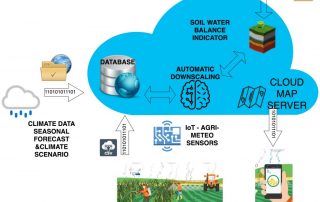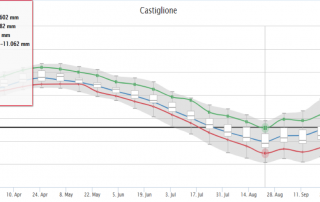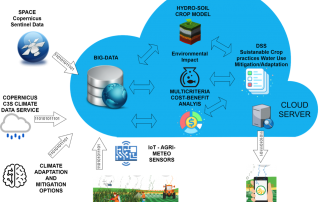Businesses involved in the production of food, from farmers to big companies, can benefit from our innovative agricultural earth observation techniques, climate projections, hydrological and data-driven model and resulting satellite-derived data analytics services.
Some of the developing challenges of this sector include coping with unpredictable weather patterns as well as longer-term changes in climate, variable water supplies as a result of droughts and floods, changing soil conditions, the need to control the impact of fertilisers and pesticides on the environment and meeting growing levels of global demand for core commodities such as wheat, sugar, palm oil, soy and beef, whilst ensuring supply chain sustainability and resilience.
At GECOsistema, we take satellite data, combine it with weather information/projections and then apply agro-meteorological and biophysical data modelling to help accurately to improve resilience, support the selection of mitigation/adaptation options, forecast and optimise crop yields.
From a technological point of view, adaptation options that sustainably increase productivity, enhance resilience to climatic stresses, and reduce greenhouse gas emissions are known as Climate-Smart Agriculture (CSA) technologies, practices and services. Climate Smart Agriculture (CSA) emphasizes the use of information and communication technology (ICT) in the cyber-physical farm and agricultural management cycle under the treats of short and long-term climate.
At the macro-environmental level, accurately forecasting crop yields can help to alleviate adverse market reactions due to potential food shortages, and ultimately help to ensure food security. Having information about crop yields can also help food processors to better control their production processes and supply chains so that they can become more efficient and sustainable producers.
GECOsistema provides services and tailored products for promoting climate-proof agriculture and irrigation technologies and practices among farmer and water managers.
Combining the the potential of ready available Open-Data collected exploiting new technologies such as Remote Sensing products (Copernicus C3S, ESA Open Data Portal, Sentinel Data) Open-Data (European Open-Data Portal), Climate Models and Services (ECMWF, CMCC, SWICCA, CLARA project), the Internet of Things and the power of Cloud Computing, GECOsistema aim to to leverage CSA and introduce more cognitive predictive tools and artificial intelligence in supporting agronomic decisions.
Our landscape intelligence service provides the strategic and operational decision makers of the water industry, agronomists, farmers and land owners with an opportunity to:
- Better manage water storage and water quality in peatlands
- Mitigate the risk of upstream water pollution by monitoring areas of high-risk
- Address pollution at source and reduce the need for additional water treatment
- Predict where and when diffuse pollutants might enter waterways
- Reduce cost and energy usage of downstream water treatment plants
- Better understand land-use changes and impact on pollutant load in a river
- Improve compliance with water quality regulations
The purpose of the assessment is to ensure that decision makers consider the environmental impacts when deciding whether or not to proceed with a project. The International Association for Impact Assessment (IAIA) defines an environmental impact assessment as “the process of identifying, predicting, evaluating and mitigating the biophysical, social, and other relevant effects of development proposals prior to major decisions being taken and commitments made.”[1]
EIAs are unique in that they do not require adherence to a predetermined environmental outcome, but rather they require decision makers to account for environmental values in their decisions and to justify those decisions in light of detailed environmental studies and public comments on the potential environmental impacts.
Strategic environmental assessment (SEA) is a systematic decision support process, aiming to ensure that environmental and possibly other sustainability aspects are considered effectively in policy, plan and programme making. In this context, following Fischer (2007)[1] SEA may be seen as:
- a structured, rigorous, participative, open and transparent environmental impact assessment (EIA) based process, applied particularly to plans and programmes, prepared by public planning authorities and at times private bodies,
- a participative, open and transparent,possibly non-EIA-based process, applied in a more flexible manner to policies, prepared by public planning authorities and at times private bodies, or
- a flexible non-EIA based process,applied to legislative proposals and other policies, plans and programmes in political/cabinet decision-making.
Effective SEA works within a structured and tiered decision framework,aiming to support more effective and efficient decision-making for sustainable development and improved governance by providing for a substantive focus regarding questions, issues and alternatives to be considered in policy, plan and programme(PPP) making.
SEA is an evidence-based instrument, aiming to add scientific rigour to PPP making, by using suitable assessment methods and techniques.
From 2005-2007, the effect of the directive was assessed. In 2010, a revised wording was published, integrated with 6 other European directives regulating large industrial sites, into the Industrial Emissions Directive, short IED.





